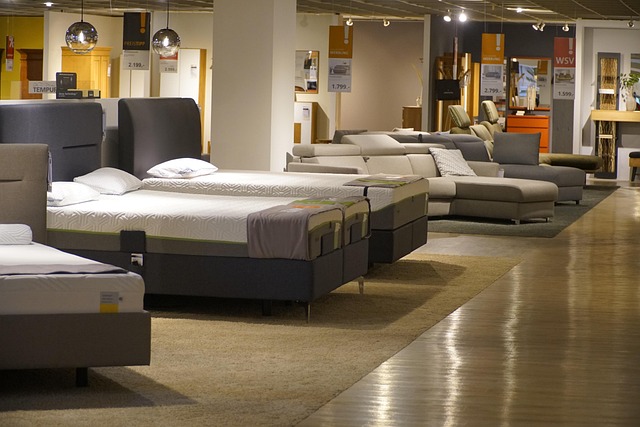Warehouse Furniture Sales: Why Last Year’s Collections Cost Less Than in Stores
When shopping for furniture, you may notice significant price differences between retail stores and warehouse sales. This price gap is particularly evident when it comes to last year's furniture collections. Warehouse sales often offer substantial discounts on previous-season items, sometimes up to 70% off retail prices. Understanding why these price differences exist can help you make more informed purchasing decisions and potentially save thousands on quality furniture pieces that simply aren't the latest models on the showroom floor.

How Furniture Warehouses Clear Inventory for New Collections
Furniture warehouses operate on a cyclical basis, with new collections typically arriving once or twice per year. To make room for incoming inventory, warehouses need to efficiently clear out previous collections. This clearance process is a fundamental part of the furniture industry’s supply chain management. Manufacturers and distributors face significant costs storing unsold furniture, as these items require substantial space in climate-controlled environments to prevent damage.
The urgency to move older inventory creates a perfect opportunity for consumers. Rather than paying for extended storage of last season’s designs, furniture companies often prefer to sell these items at reduced prices. This approach allows them to recoup a portion of their investment quickly rather than waiting for full-price sales that might never materialize. For shoppers, this translates to substantial savings on furniture that, while not the most current design, is still new and unused.
The Economics of Bulk Furniture Sales
Last season’s furniture items frequently become available through bulk sales processes, which fundamentally changes their pricing structure. When retailers purchase display models or entire remaindered collections at once, they benefit from significant wholesale discounts. These savings occur because manufacturers save on packaging, individual shipping, and handling expenses associated with selling pieces separately.
Bulk selling eliminates many costly touchpoints in the distribution chain. For example, a manufacturer might sell an entire shipment of 50 sofas to a warehouse outlet in one transaction rather than processing 50 individual orders through traditional retail channels. This streamlined approach reduces administrative costs, logistics expenses, and individual product handling. The warehouse can then pass these savings directly to consumers while still maintaining profitable margins.
Retail Markup: Showrooms and Marketing Costs
Traditional furniture retailers operate with a business model that necessarily includes substantial overhead expenses absent from warehouse operations. When you purchase a sofa from a high-end furniture boutique, you’re not just paying for the furniture itself but also for the elaborate showroom experience. These retail environments typically feature professionally designed displays, mood lighting, and strategic arrangements that help customers envision pieces in their homes.
Additional retail costs that influence pricing include:
-
Showroom rent in premium shopping districts or malls
-
Utilities and maintenance for large, climate-controlled display spaces
-
Professional interior designers to create aspirational room settings
-
Sales staff trained in home furnishing and design principles
-
Marketing campaigns across multiple channels
-
Extended floor time for slow-moving inventory
These expenses collectively contribute to retail markup rates that typically range from 200% to 400% above wholesale pricing, explaining why identical pieces cost significantly more in traditional stores than at warehouse sales.
The Hidden Savings: Discontinued Models and Slight Imperfections
Warehouse furniture sales often include discontinued models or pieces with minor cosmetic imperfections that wouldn’t meet the stringent display standards of high-end retailers. These imperfections might include barely noticeable flaws like slight color variations in natural materials, minor scratches on less visible surfaces, or small weaving irregularities in upholstery fabrics.
For savvy shoppers, these minor issues represent major savings opportunities. A sofa with a small fabric irregularity on its back side (which would typically face a wall) might sell for 30-50% less than its flawless counterpart, despite having identical structural integrity and comfort. Similarly, discontinued fabric options or finishes—often indistinguishable from current offerings to the untrained eye—provide exceptional value for cost-conscious consumers.
Warehouse vs. Retail Furniture: Pricing Comparison
When comparing warehouse and retail prices for similar furniture pieces, the differences become strikingly apparent. Below is a comparison of typical price points for common furniture items across different sales channels:
| Furniture Item | Average Retail Store Price | Average Warehouse Sale Price | Typical Savings |
|---|---|---|---|
| Leather Sofa | $2,400 - $3,500 | $1,200 - $1,800 | 45% - 55% |
| Dining Table (Solid Wood) | $1,800 - $2,500 | $800 - $1,200 | 50% - 60% |
| Queen Mattress (Premium) | $1,200 - $2,000 | $600 - $900 | 50% - 65% |
| Sectional Sofa | $3,500 - $5,000 | $1,700 - $2,500 | 50% - 60% |
| Bedroom Set (5-piece) | $3,800 - $6,000 | $1,900 - $3,000 | 45% - 65% |
Prices, rates, or cost estimates mentioned in this article are based on the latest available information but may change over time. Independent research is advised before making financial decisions.
When to Shop Warehouse Sales for Maximum Value
Timing can significantly impact the availability and pricing of warehouse furniture. Industry patterns show that warehouse sales tend to align with new inventory arrivals, typically occurring in January/February and July/August. These periods coincide with major furniture trade shows where manufacturers unveil new collections, creating pressure to clear existing inventory.
End-of-quarter sales can offer particularly aggressive discounts as warehouses strive to meet financial targets. Additionally, large warehouses often implement progressive discount structures, where prices decrease the longer an item remains unsold. This means that patient shoppers willing to monitor inventory over several weeks might secure even deeper discounts, though with increased risk that desirable pieces will sell before reaching maximum markdown.
For consumers with flexible timelines and storage capacity, these seasonal patterns offer opportunities to furnish entire homes or update specific rooms at a fraction of retail costs, often with only minor compromises on having the absolute latest design trends.
Understanding the economic factors behind warehouse furniture pricing empowers consumers to make strategic purchasing decisions. While retail showrooms offer convenience and the latest designs, warehouse sales provide exceptional value for those willing to shop last year’s collections, especially when the style differences are minimal or even unnoticeable to most observers.




